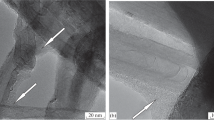Summary
Living cells of Mycobacterium sp. NRRL B-3683 were immobilized by adsorption on different types of solid carriers in order to produce androsta-1,4-diene-3,17-dione (ADD) from cholesterol. Activated alumina proved to be the most preferred carrier for long-term operation when glucose and peptone were added to the reaction medium. In a repeated-batch process, the maximum productivity of ADD was about 0.19 g/l per day with a molar conversion rate of 77% when 1.0 g/l of cholesterol was added to the reaction medium. The half-life of the immobilized cells was more than 45 days and the system could be reactivated by incubating the immobilized cells in a cell growth medium.
Similar content being viewed by others
References
Buchs J, Mozes N, Wandrey C, Rouxhet PG (1988) Cell adsorption control by culture conditions: influence of phosphate on surface properties, flocculation and adsorption behaviour of Corynebacterium glutamicum. Appl Microbiol Biotechnol 29:119–128
Buckland BC, Dunnill P, Lilly MD (1975) The enzymatic transformation of water-insoluble reactants in nonaqueous solvents: conversion of cholesterol to cholest-4-ene-3-one by a Nocardia sp. Biotechnol Bioeng 17:815–826
Dighe AS, Patel PM, Rao KK (1985) Effect of phosphate on the estimation of reducing sugars in biological media. Biotechnol Bioeng 27:1612–1615
Duarte JMC, Lilly MD (1984) Cholesterol degradation by polymer-entrapped Nocardia in organic solvents. Enzym Eng 7:573–576
El-Aassar SA, Omar SH, Rehm HJ (1988) Oxidation of n-tetradecane by Candida parapsilosis KSh 21 adsorbed on different glass rings. Appl Microbiol Biotechnol 29:442–446
Flygare S, Larsson PO (1987) Steroid transformation using magnetically immobilized Mycobacterium sp. Enzyme Microb Technol 9:494–499
Flygare S, Larsson PO (1989) Steroid transformation in aqueous two-phase systems: side-chain degradation of cholesterol by Mycobacterium sp. Enzyme Microb Technol 11:752–759
Fukui S, Tanaka A (1982) Immobilized microbial cells. Ann Rev Microbiol 36:145–172
Haberland ME, Reynolds JA (1973) Self-association of cholesterol in aqueous solution. Proc Nat Acad Sci USA 70:2313–2316
Imada Y, Ishikawa H, Nishikawa (1981) Development of new steroid fermentation. Nippon Nogeikagaku Kaishi 55:713–721
Kolot FB (1982) Microbial catalysts for steroid transformation: part 1. Process Biochem 17 (6):12–18
Kolot FB (1983) Microbial catalysts for steroid transformation: part 2. Process Biochem 18(1):19–21
Koscheyenko KA, Turkina MV, Skryabin GK (1983) Immobilization of living microbial cells and their application for steroid transformation. Enzyme Microb Technol 5:14–21
Lee CY, Liu WH (1990) Microbial transformation of cholesterol to androsta-1,4-diene-3,17-dione by kappa-carrageenan-entrapped cells of Mycobacterium sp. NRRL B-3683. J Chin Agric Chem Soc 28:276–284
Lenz GR (1983) Steroids. In: Brown J, Eastman CI, Golojuch C, Klingsberg A, Wainwright M (eds) Kirk-Othmer Encyclopedia of Chemical Technology, 3rd edn, vol 21. Wiley, New York, p 645
Liu WH, Lee CY (1990) Microbial transformation of cholesterol to androsta-1,4-diene-3,17-dione by Mycobacterium sp. NRRL B-3683 in a cholesterol-synthetic medium. J Chin Agric Chem Soc 28:166–174
Marsheck WJ, Kraychy S, Muir R (1972) Microbial degradation of sterols. Appl Microbiol 23:72–77
Mozes N, Rouxhet PG (1984) Dehydrogenation of cortisol by Arthrobacter simplex immobilized as supported monolayer. Enzyme Microb Technol 6:497–502
Mozes N, Rouxhet PG (1985) Metabolic activity of yeast immobilized as supported monolayer. Appl Microbiol Biotechnol 22:92–97
Oshima T, Kimura F, Komata T, Iwamoto Y (1984) Method for the fermentative production of androsta-1,4-diene-3,17-dione. Japanese patent publication SHO59-37078
Jr Wingard LB, Roach RP, Miyawaki O, Egler KA, Klinzing GE, Silver RS, Brackin JS (1985) Epoxidation of propylene utilizing Nocardia corallina immobilized by gel entrapment or adsorption. Enzyme Microb Technol 7:503–509
Author information
Authors and Affiliations
Rights and permissions
About this article
Cite this article
Lee, CY., Liu, WH. Production of androsta-1,4-diene-3,17-dione from cholesterol using immobilized growing cells of Mycobacterium sp. NRRL B-3683 adsorbed on solid carriers. Appl Microbiol Biotechnol 36, 598–603 (1992). https://doi.org/10.1007/BF00183235
Received:
Accepted:
Issue Date:
DOI: https://doi.org/10.1007/BF00183235



